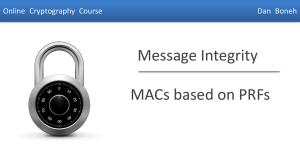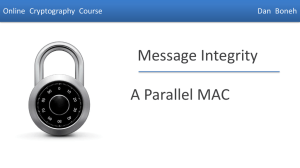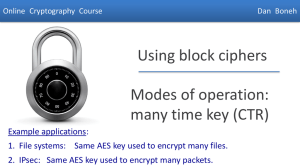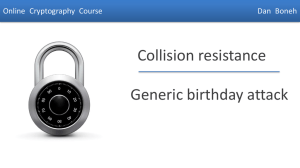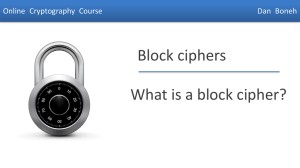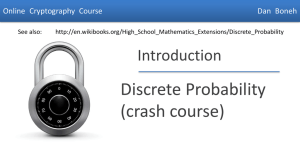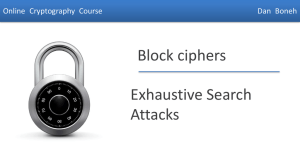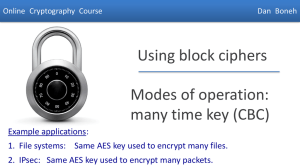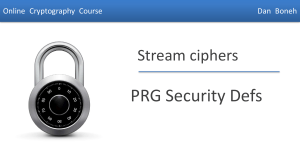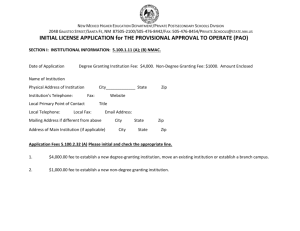PPT for CBC-MAC and NMAC
advertisement
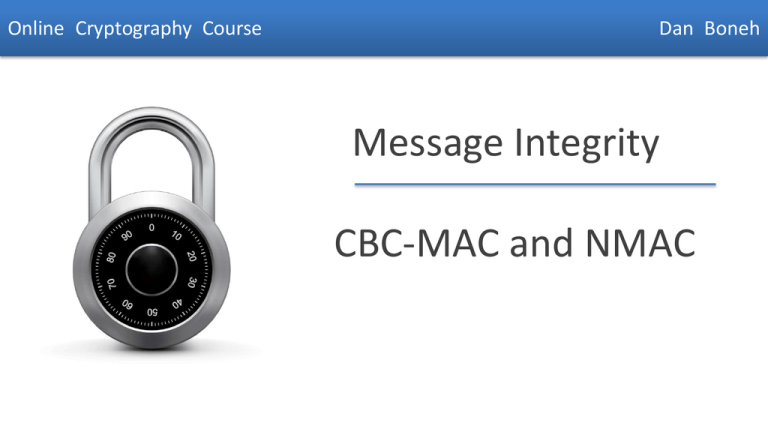
Online Cryptography Course
Dan Boneh
Message Integrity
CBC-MAC and NMAC
Dan Boneh
MACs and PRFs
Recall: secure PRF F ⇒ secure MAC,
S(k, m) = F(k, m)
as long as |Y| is large
Our goal:
given a PRF for short messages (AES)
construct a PRF for long messages
From here on let X = {0,1}n (e.g. n=128)
Dan Boneh
Construction 1:
encrypted
CBC-MAC
raw CBC
m[0]
F(k,)
m[1]
m[3]
m[4]
F(k,)
F(k,)
F(k,)
Let F: K × X ⟶ X be a PRP
Define new PRF FECBC : K2 × X≤L ⟶ X
F(k1,)
tag
Dan Boneh
Construction 2: NMAC
(nested MAC)
cascade
m[0]
k
>
F
m[1]
>
F
m[3]
>
F
Let F: K × X ⟶ K be a PRF
Define new PRF FNMAC : K2 × X≤L ⟶ K
m[4]
>
F
t
k1
t ll fpad
>
F
tag
Dan Boneh
Why the last encryption step in ECBC-MAC and NMAC?
NMAC: suppose we define a MAC I = (S,V)
where
S(k,m) = cascade(k, m)
This MAC is secure
This MAC can be forged without any chosen msg queries
This MAC can be forged with one chosen msg query
This MAC can be forged, but only with two msg queries
Why the last encryption step in ECBC-MAC?
Suppose we define a MAC IRAW = (S,V)
where
S(k,m) = rawCBC(k,m)
Then IRAW is easily broken using a 1-chosen msg attack.
Adversary works as follows:
– Choose an arbitrary one-block message mX
– Request tag for m. Get t = F(k,m)
– Output t as MAC forgery for the 2-block message (m, tm)
Indeed: rawCBC(k, (m, tm) ) = F(k, F(k,m)(tm) ) = F(k, t(tm) ) = t
Dan Boneh
ECBC-MAC and NMAC analysis
Theorem:
For any L>0,
For every eff. q-query PRF adv. A attacking FECBC or FNMAC
there exists an eff. adversary B s.t.:
AdvPRF[A, FECBC] AdvPRP[B, F] + 2 q2 / |X|
AdvPRF[A, FNMAC] q⋅L⋅AdvPRF[B, F] + q2 / 2|K|
CBC-MAC is secure as long as q << |X|1/2
NMAC is secure as long as q << |K|1/2
(264 for AES-128)
Dan Boneh
An example
AdvPRF[A, FECBC] AdvPRP[B, F] + 2 q2 / |X|
q = # messages MAC-ed with k
Suppose we want AdvPRF[A, FECBC] ≤ 1/232
• AES:
⇐ q2 /|X| < 1/ 232
|X| = 2128 ⇒ q < 248
So, after 248 messages must, must change key
• 3DES: |X| = 264 ⇒ q < 216
Dan Boneh
The security bounds are tight: an attack
After signing |X|1/2 messages with ECBC-MAC or
|K|1/2 messages with NMAC
the MACs become insecure
Suppose the underlying PRF F is a PRP (e.g. AES)
• Then both PRFs (ECBC and NMAC) have the following
extension property:
∀x,y,w: FBIG(k, x) = FBIG(k, y)
⇒ FBIG(k, xllw) = FBIG(k, yllw)
Dan Boneh
The security bounds are tight: an attack
Let FBIG: K × X ⟶ Y be a PRF that has the extension property
FBIG(k, x) = FBIG(k, y)
⇒ FBIG(k, xllw) = FBIG(k, yllw)
Generic attack on the derived MAC:
step 1: issue |Y|1/2 message queries for rand. messages in X.
obtain ( mi, ti )
for i = 1 ,…, |Y|1/2
step 2: find a collision tu = tv for u≠v (one exists w.h.p by b-day paradox)
step 3: choose some w and query for t := FBIG(k, mullw)
step 4: output forgery (mvllw, t).
Indeed t := FBIG(k, mvllw)
Dan Boneh
Better security: a rand. construction
2 blocks
m
k1
>
rawCBC
t
>
k
rand. r in X
Let F: K × X ⟶ X be a PRF.
Security:
r
tag
rawCBC
Result: MAC with tags in X2.
AdvMAC[A, IRCBC] AdvPRP[B, F] ⋅ (1 + 2 q2 / |X| )
⇒ For 3DES: can sign q=232 msgs with one key
Dan Boneh
Comparison
ECBC-MAC is commonly used as an AES-based MAC
• CCM encryption mode (used in 802.11i)
• NIST standard called CMAC
NMAC not usually used with AES or 3DES
• Main reason: need to change AES key on every block
requires re-computing AES key expansion
• But NMAC is the basis for a popular MAC called HMAC (next)
Dan Boneh
End of Segment
Dan Boneh
